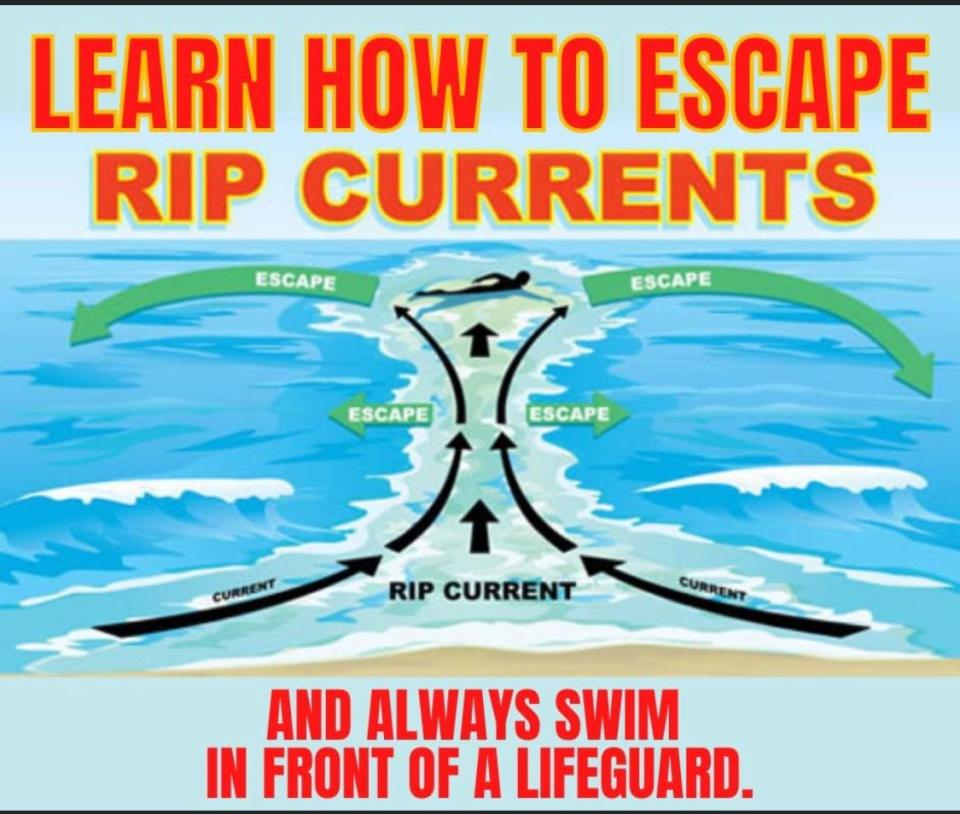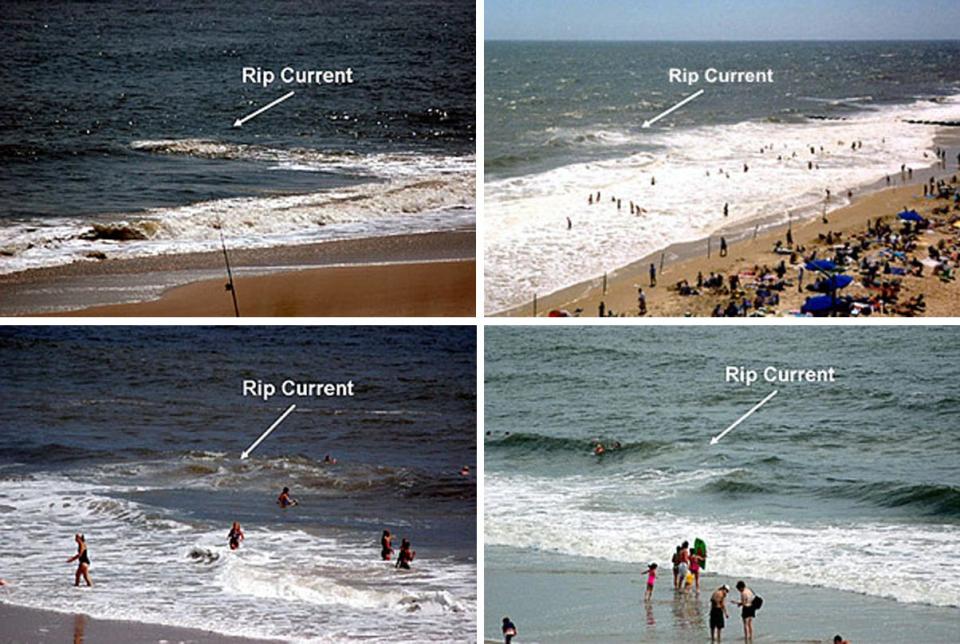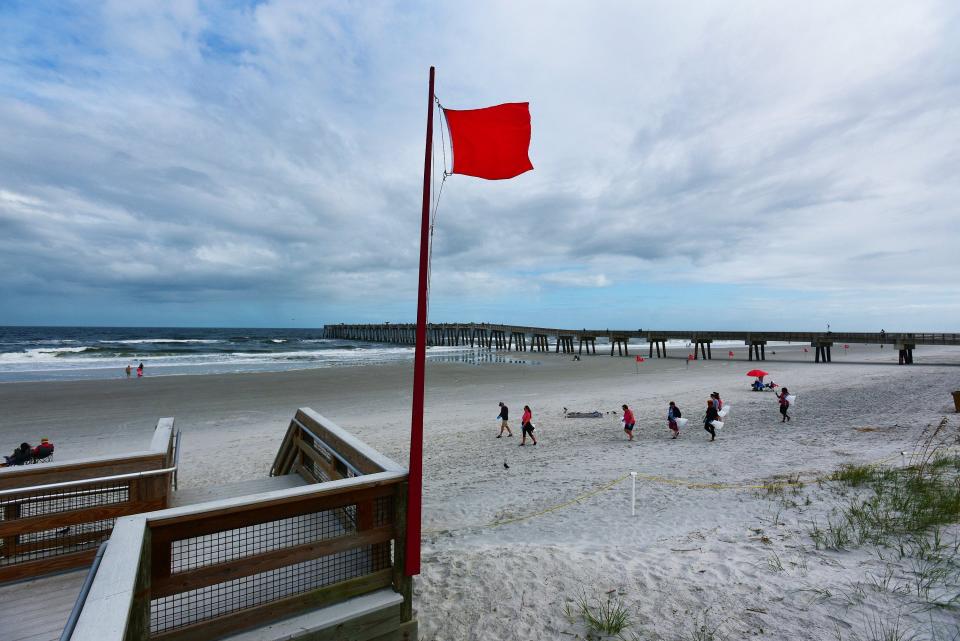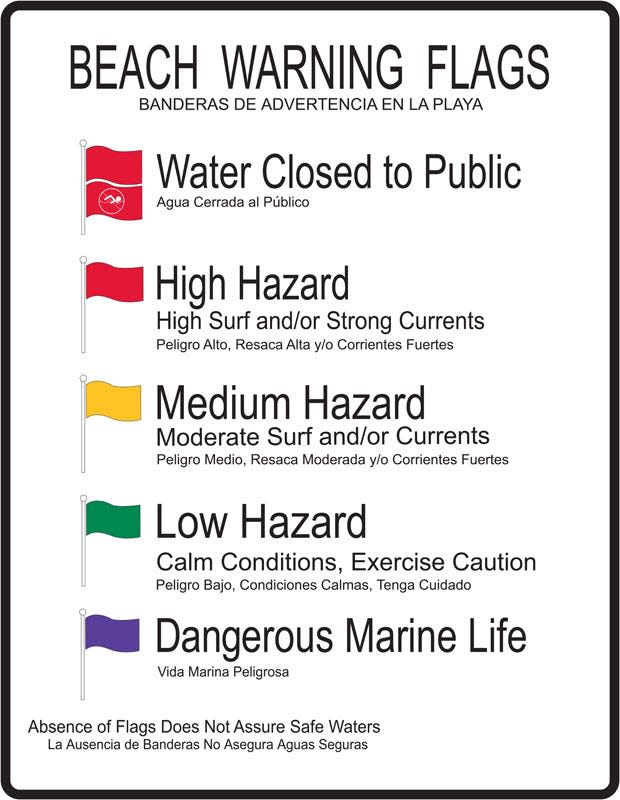3 Panama City Beach drownings bring Florida total to 6 this week. How to survive rip currents
There have now been six reported fatal drownings in Florida in two days with the latest being three men who died in the surf off Panama City Beach on Friday night.
Those deaths come just a day after two other tragic swimming deaths in Stuart Beach, Florida. Parents of six children vacationing in Martin County from Pennsylvania were swimming when they could not escape a rip current.
Much of the Southeast Florida coast and Panhandle beaches have been under high risk rip current advisories this week, as was the case Friday evening, according to the National Weather Service. The Weather Service updated its advisory stating that dangerous rip currents for Bay County are expected throughout the weekend.
This being only the start of summer, rip currents will be a regular threat for months.
A disturbance off the east coast is churning up waters off Florida's Atlantic coast, while the Gulf of Mexico was stirred by Tropical Storm Alberto and another area of low pressure that could form into a storm system soon.
Walton, Bay, Gulf and Franklin County beaches were under an advisory on Friday night around the time the men died.
"Rip currents can sweep even the best swimmers away from shore into deeper water," the NWS said.
"Swim near a lifeguard. If caught in a rip current, relax and float. Don`t swim against the current. If able, swim in a direction following the shoreline. If unable to escape, face the shore and call or wave for help."
Last year, there were 301 ocean rescues over the Memorial Day weekend in Volusia County alone. and 43 this year. In March, a tourist was pulled 75 yards out into the Gulf of Mexico and was rescued by the Bay County Sheriff's Office and Bay County Fire Rescue.
Here's what you need to know if you or someone you know is going into the ocean when there are rip currents present.
3 Alabama men drown in Bay County
According to a Facebook post from the agency, three men, whose ages and hometowns have not yet been listed, arrived in Bay County Friday evening and went swimming.
The Bay County Sheriff's Office said it received a call at 8:11 p.m. Friday about three distressed swimmers behind Watercress Condominiums, 6201 Thomas Drive. The agency, along with the U.S. Coast Guard, Bay County Emergency Services and the Florida Fish and Wildlife Conservation Commission, began rescue efforts. The swimmers were found individually.
Where was the Friday Bay County Florida drowning incident?
Rescue crews responded to the Gulf waters behind Watercress Condominiums, 6201 Thomas Drive.
Oklahoma man drowns at Panama City Beach
A 19-year-old man from Oklahoma drowned in the Gulf of Mexico on Thursday (June 20) in Panama City Beach. The young man was on vacation and no other details of his death were released.
Couple drowns in Florida after getting caught in rip current off Hutchinson Island
On Thursday, June 20, Brian Warter, 51, and Erica Wishard, 48, who were vacationing from Pennsylvania with their six kids, were swimming off Stuart Beach when they were caught in a rip current.
"Despite what was described as an immediate effort to reach the family caught in the rip current south of the guarded Stuart Beach area, the man and woman died after lifesaving efforts of Martin County Fire Rescue Ocean Rescue and medical workers at Cleveland Clinic Martin North Hospital where they were taken in what was said to be serious condition and later declared dead," TCPalm reported.
"Two of (their) teenage children were also swept out by the current and attempted to save their parents but as water conditions worsened they were able to free themselves and swim to shore, according to Martin County Sheriff’s Office."
What is a rip current?
Rip currents are powerful, concentrated channels of water flowing quickly away from shore, most often found at low spots or breaks in the sandbar and near structures such as jetties and piers.
Rip currents form when incoming waves create an underwater sandbar. The waves push more water between the sandbar and the shore until it collapses and the water rushes back to the sea through a narrow gap, where it starts to spread out. But they can be difficult to see when you're in the water as the ocean over them can still be smooth.
Rip currents often form during or after stormy weather but can form on bright, sunny days just as easily since the weather isn't really what's causing them. Rip currents can be found at any beach with waves, at any time.
What happens in a rip current?
You're swimming along, enjoying the cool ocean water off a Florida beach, when suddenly you get knocked off your feet and feel like you're in a rushing underwater river. You try swimming to shore but the current has you in its grip, pulling you farther out to sea.
Eventually, the current will dissipate, but not before it drags you along no matter how strong a swimmer you are. Fortunately, they're not difficult to deal with if you keep your head.
How many people die in rip currents?
Rip currents are habitual hazards of Florida beaches. Tens of thousands are rescued from rip currents in the U.S, every year and they make up 81.9% of all surf beach rescues, according to a 2018 report from the Natural Hazards and Earth System Sciences on lifeguard data.
The United States Lifesaving Association (USLA) has estimated that over 100 people drown every year in this country due to rip currents.
How far out do rip currents go?
Sometimes rip currents end right after where the waves are breaking, sometimes they keep pulling hundreds of yards offshore. A rip current's strength and speed can vary wildly within a matter of minutes.
How fast do rip currents move?
Rip currents usually move around 1-2 feet per second, but can speed up to 8 feet per second. That's 5.45 miles per hour, which doesn't sound fast if you're driving but is faster than Olympic swimmer Michael Phelps. The average human being tends to swim up to about 2 mph.
A rip current is typically the strongest about a foot off the bottom of the ocean floor, according to the National Oceanic and Atmospheric Administration (NOAA), which can cause your feet to get knocked out from under you and increase the feeling of being dragged along.
Can you swim away from a rip current?
While you're in it, it can feel relentless.
Even strong, experienced swimmers caught in a rip current can easily tire themselves out trying to swim back to shore against a rip current.
What is the best thing to do in a rip current?

By far the most important thing to do is to stay calm, and even try to relax. They can be scary, but rip currents will only pull you along, they won't pull you under the water. The biggest danger is tiring yourself out.
Don't panic or thrash about. Don't bother trying to fight the current.
You may be able to get out of the current by swimming with it parallel to the shore (or just floating or treading water) until it fades or circulates back to shore, and then you can swim to the beach.
You also can try swimming with the current toward breaking waves, where you may be able to swim for shore.
If you can't reach the shore or you're being pulled farther out to sea, or you're getting tired, draw attention to yourself by waving or shouting for help.
What do I do if I see someone caught in a rip current?
The second biggest danger from rip currents is from people trying to rescue someone else and drowning themselves. It's a perfectly natural impulse that may cause more harm than good. If you see someone in that situation:
Get a lifeguard.
If there isn't a lifeguard nearby, call 9-1-1.
Try to tell the victim to stay calm and swim along the shoreline.
If it's possible and you can do so safely, throw the victim something that floats.
What does a rip current look like?

Before you even go near the water, check the conditions. There are several ways.
Check the forecast. The National Weather Service issues rip current statements or you can check current Florida rip current risks at weather.gov/beach/florida.
At the beach, look for warning flags at beach approaches or lifeguard station. Red flags mean dangerous rip current activity is expected. Double red flags mean the water is closed to the public.
Ask a lifeguard. Don't be shy, any lifeguard would be happy to let you know if it's dangerous to go in the water.
Stand back where you can see the ocean's surface and check for visible gaps of darker, flat spots in lines of breaking waves; a channel of churning, choppy water; a difference in water color; or a line of foam, seaweed or debris moving back toward the sea. But rip currents can be subtle and hard to identify, according to NOAA.
How do I protect myself and my family from rip currents?
Being aware of conditions is important, but a rip current may still catch you unaware. Here's how to plan ahead.
Always swim near a lifeguard, and ask one about water conditions. Teach your children to do the same.
Assume that rip currents are out there, whether there's a warning or not.
Make sure that you and your family know how to swim in the surf. Being good in the pool doesn't mean you can handle the ocean.
Consider flotation devices for anyone who may have problems staying above water for extended periods of time.
What do the beach warning flags mean?


Watch for beach warning flags at lifeguard towers, stations and other locations for a heads-up on current conditions and potential dangers.
Double red flags mean the water is closed to the public.
A red flag is high hazard, meaning high surf and/or strong currents.
A yellow flag is medium hazard, meaning moderate surf and/or currents.
A green flag is low hazard, meaning calm conditions, exercise caution.
A purple flag means that dangerous marine life spotted.
What is the difference between a riptide and a rip current?
Rip currents have also been called runouts, but they're not the same as rip tides or undertow although the terms often get confused.
Rip currents: Strong offshore currents that run along the shoreline or back out to sea.
Rip tides: A powerful current caused by the tide pulling water through an inlet and the mouths of estuaries, embayments, and harbors. Also known as tidal jets.
Undertow: When a wave breaks, a lot of water and sand is pulled rapidly under the surface back into the next breaking wave. Unprepared swimmers or small children can easily be tumbled around in an undertow but it only goes a short distance and only for a moment or so.
This article originally appeared on The News Herald: Rip currents and Florida drownings: How to escape rough surf

